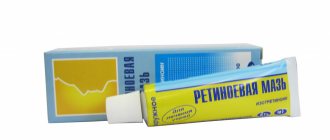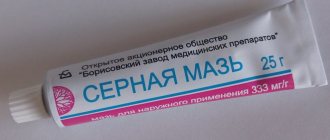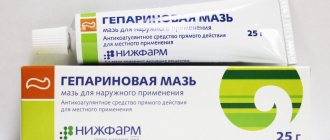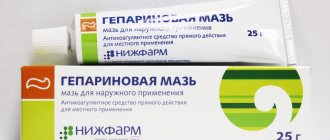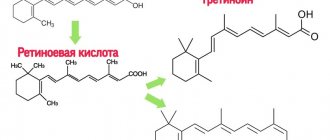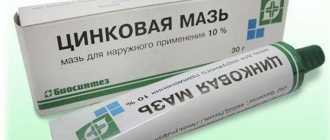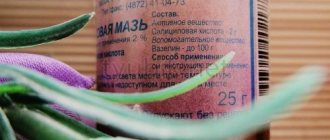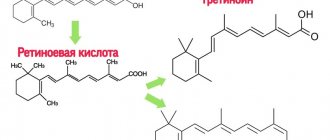Skin problems can arise at any age: during adolescence, acne appears on the face due to hormonal changes, and with age, the skin loses its elasticity and wrinkles begin to appear.
Retinoic ointment is a universal remedy for solving cosmetic problems; it is sold in pharmacies and is classified as a medicine.
What is Retinoic ointment
The main component of the ointment is isotretinoin, its content can be 0.05 g or 0.1 g. The substance is a biologically active form of retinol (vitamin A), which affects the process of cell differentiation.
Excipients include petroleum jelly, glycerin, ethyl alcohol, emulsion wax, dibunol, distilled water and butyloxyanisole.
The product is a yellowish substance of uniform consistency without inclusions. Packaged in tubes of 10 or 15 g, sold in boxes along with instructions.
Registration number:
P N000556/01
Trade name:
Retinoic ointment
International nonproprietary name:
isotretinoin
Dosage form:
ointment for external use.
Compound:
- Active ingredient:
isotretinoin 0.05 or 0.1 g. - Excipients:
butylated hydroxytoluene – 0.05 g, butylated hydroxyanisole – 0.025 g, emulsion wax – 8.0 g, petroleum jelly – 8.0 g, glycerol (glycerin) – 10.0 g, ethanol (ethyl alcohol) 95% – 10 .0 g, purified water up to 100 g.
Description:
homogeneous ointment from light yellow to yellow.
Pharmacotherapeutic group:
tissue regeneration stimulator.
ATX code:
(D10AD04)
Pharmacological properties
Isotretinoin is one of the biologically active forms of vitamin A. It inhibits the terminal differentiation of sebocytes and hyperproliferation of the epithelium of the excretory ducts of the sebaceous glands, normalizes the composition of their secretions and facilitates its evacuation. Due to this, sebum production is reduced and the inflammatory reaction around the glands is reduced. The ointment has an antiseborrheic, anti-inflammatory, keratolytic effect, and enhances regeneration processes in the skin.
Indications for use
Acne vulgaris, seborrheic dermatitis, rosacea, perioral dermatitis.
Contraindications
Use with caution in chronic diseases of the liver, kidneys, chronic pancreatitis, cardiac decompensation.
Pregnancy and lactation
It is not recommended to apply to large areas of skin during pregnancy, breastfeeding and women planning pregnancy.
Directions for use and doses
The ointment is applied in a thin layer to the affected areas of the skin twice a day. Duration of treatment is 4-12 weeks. A repeated course of treatment is possible after consultation with a doctor.
Side effects
In the second week of treatment, an exacerbation reaction is possible - the appearance of new rashes, itching, redness and peeling of the skin. If the reaction is severe, it is recommended to stop treatment for several days until it subsides. In some cases, with individual sensitivity, maculopapular rashes, itching and swelling appear on the first or second day of use. In such cases, the drug should be discontinued. With prolonged use, symptoms of chronic hypervitaminosis A may develop (cheilitis, conjunctivitis, dryness and flaking of the skin).
Interaction with other drugs
The ointment should not be prescribed to patients receiving other drugs from the retinoid group in order to reduce the risk of hypervitaminosis A. The effect of the ointment is weakened by simultaneous local use of glucocorticosteroids.
special instructions
It is not recommended to apply the ointment to the skin around the eyes, or in cases of severe acute inflammation. Do not apply to mucous membranes. During treatment, you should avoid exposure to the sun; if necessary, use sunscreen; preventive and therapeutic use of ultraviolet rays and visiting a solarium are not recommended.
The drug does not affect the ability to drive a car or perform work that requires increased concentration.
Release form
Ointment for external use 0.05% and 0.1%.
Aluminum tubes of 10, 15, 20 and 35 g. The tube, along with instructions for use, is placed in a cardboard pack.
Storage conditions
At temperatures from 2 to 8 °C. Do not allow freezing. Keep out of the reach of children.
Best before date
2 years. Do not use after expiration date.
Conditions for dispensing from pharmacies
Over the counter.
Mechanism of action of Retinoic ointment
The instructions for Retinoic ointment contain information that the drug belongs to dermatotropic agents. This means that the composition protects the skin from microbes and parasites, stimulates the healing process and renewal of the epidermis.
Due to retinoic acid, the product provides:
- anti-inflammatory effect;
- exfoliating effect;
- antiseborrheic effect;
- dermatoprotective effect.
Isotretinoin has proven effectiveness in the treatment of dermatitis, normalizes the functioning of the sebaceous glands and thereby relieves acne, pimples and acne.
Glycerin present in the composition helps smooth the skin, and ethanol has an antibacterial effect and improves blood circulation. The medicinal composition is able to penetrate into the deep layers of the skin and inhibit the production of sebum, preventing the expansion of the diameter of the sebaceous ducts and their clogging with secretions. The ointment improves the removal of fat, due to which the inflammatory process is relieved, and the pores are narrowed, giving the skin a healthy and even appearance.
Composition and release form
Retinoic ointment is a greasy, light-yellow product of uniform consistency, which contains Isotretinoin. It is this substance that determines the high biological activity of the drug. Isotretinoin belongs to the group of Retinoids and is a type of retinoic acid along with Tretinoin, which is more toxic and for this reason is rarely used.
Retinoids are substances close in structure and physiological action to Vitamin A - Retinol, and are chemically similar to it.
For clarity, the relationship between the chemical structure of vitamin A and its derivatives is shown below.
Isotretinoin is shown on the left and is completely cis-retinoic acid, that is, its chemical configuration in which the functional group is in the same plane as the double bond. Cis isomers are more reactive, i.e. have greater biological activity. In addition, it is safer than trans-retinoic acid - Tretinoin .
To date, among the six drugs registered in Russia, Isotretinoin Retinoic ointment is the only dosage form in the form of an ointment.
Therefore, if you come across a drug in the pharmacy in the form of an ointment or cream with a different name, where this active substance is indicated, then keep in mind that this is a counterfeit or fake.
The patent and rights to produce this ointment belong to the pharmaceutical industry.
Retinoic ointment is available in two concentrations:
0.5% - containing 0.05 g of Isotretinoin per 10 g of ointment and 1% containing 0.1 g, respectively.
The ointment also contains auxiliary components:
- Dibunol (antioxidant, antioxidant);
- Butyloxyanisole (antioxidant, preservative, acidity regulator);
- Emulsion wax (emulsifier);
- Vaseline oil (lipophilic base);
- Glycerin (density regulator, solvent, has a moisturizing effect on the skin);
- Ethyl alcohol (solvent, preservative);
- Purified water.
Retinoic ointment for wrinkles
Dermatologists who prescribe Retinoic ointment for the treatment of skin diseases note that as a result of use, the face is further transformed: the face becomes elastic, the skin is tightened and thickened, rashes and wrinkles disappear.
Conducted scientific studies confirm that isotretinoin, when applied systematically, is capable of:
- have a rejuvenating effect on the skin;
- increase elasticity and firmness;
- renew the epidermis due to intensive exfoliation of the dead layer of cells;
- improve skin tone;
- make the skin denser and thicker;
- restore tissue, smooth out deep wrinkles, including around the eyes, creases;
- indirectly stimulate the production of collagen, hyaluronic acid and elastin, which smooth the surface and increase tightness.
Thus, having noticed the first age-related changes, such as sagging skin, paleness of the face, wrinkles, start using Retinoic ointment, which can be applied not only to the face, but also to the shoulders, hips and back.
Analogs
This unique drug has many effects and indications, so for each of them we have indicated separate analogues.
For clarity, analogues of Retinoic ointment are divided into groups, which can be seen in the table.
Retasol
Isotretionin preparation in the form of a 2.5% solution for external use. Contains propylene glycol and ethyl alcohol as auxiliary components. The higher concentration is due to the liquid dosage form. The main indications are also:
- Acne;
- Seborrheic dermatitis;
- Rosacea;
- Perioral dermatitis.
Due to its higher concentration, Retasol is not recommended for use on thin and damaged skin, especially under the eyes. Also, the liquid form is less effective for use against wrinkles.
The solution must be stored in the refrigerator.
We see
It is an ointment containing Retinol - Vitamin A. The remaining components are almost the same as Retinoic ointment, only the antioxidant components differ. The compositions of the products can be compared in the table .
| Retinoic ointment | Ointment Videstim |
| Dibunol | Butylated hydroxytoluene |
| Butyloxyanisole | Butylated hydroxyanisole |
| Emulsion wax | Emulsion wax |
| Vaseline oil | Vaseline oil |
| Glycerol | Glycerol |
| Ethanol | Ethanol |
| Purified water | Purified water |
The manufacturer is also
The official instructions for Videstim ointment include a number of indications for which this product can be used, including:
- Eczema;
- Dermatitis, including atopic dermatitis in the absence of exacerbation (i.e. in remission);
- Excessive pigmentation (cheilitis), including age-related;
- Age-related skin changes (meaning wrinkles); diseases associated with impaired skin keratinization processes, such as hyperkeratosis;
- To activate skin restoration processes after glucocorticosteroid therapy.
When the drug is contraindicated, side effects
Like any medicine, the ointment has contraindications for use:
- planning conception, pregnancy, breastfeeding (cannot be applied to large areas of the skin);
- taking other retinoid drugs to avoid overdose.
With caution, it can be used by persons with chronic kidney and liver diseases, chronic pancreatitis, and severe heart failure.
Undesirable effects may occur during treatment:
- personal intolerance to the substance and auxiliary ingredients;
- the appearance of new rashes from the second week of use, redness of the skin, which does not require cessation of therapy.
When used for a long period, increased dryness of the skin with peeling, conjunctivitis, inflammation of the mucous membrane and skin of the lips may occur.
How to apply anti-wrinkle ointment
If Retinoic ointment is used for wrinkles, then the following procedure must be followed:
- Cleanse your face of decorative cosmetics using toner.
- Dry the skin with a clean towel or dry cloth.
- Apply the ointment to the face and décolleté in a thin layer.
It is better to carry out the procedure once a day before bed to allow the drug to be absorbed.
You can apply the composition as a mask for 40-60 minutes and rinse with warm water, and then use a moisturizer.
It is important to understand that the result will become noticeable with regular use.
Indications for use
According to the official instructions for the use of Retinoic ointment, there are only a few indications for its use:
- Acne;
- Seborrheic dermatitis;
- Rosacea;
- Perioral dermatitis (“jams”, cracks in the corners of the lips).
However, given the positive effects of this ointment, there are several non-trivial indications for which it can be used, among them:
- Treatment of fresh scars, scars and stretch marks;
- Treatment of post-inflammatory hyperpigmentation, post-acne (after acne and wounds);
- Reduction of facial and age wrinkles that appear due to decreased skin turgor;
- Treatment of ingrown hairs after depilation.
Rules of application
Although this drug is intended for the skin regardless of location, Retinoic ointment is still more often used specifically for the facial skin.
Let's consider the methods and features of its use in each specific case, but before that it is worth learning a few general recommendations:
- Treatment with the drug should be started with a lower concentration, especially for those who use this drug for the first time;
- For people with very thin and sensitive skin, it is recommended to mix a small amount with Vaseline oil 1:1, gradually increasing the percentage of ointment, this way you will be able to avoid burns on the skin;
- Treatment should be continued for at least a month (as for most retinoids) provided there are no adverse reactions;
- When using Retinoic ointment under the eyes, do not apply it close to the eye, especially in high concentrations;
- When applying around the eyes, retreat 1-1.5 cm from the eye, apply in a thin layer and do not rub into the skin, but rather use the advice from step 2;
- Under no circumstances should this product be applied in the form of a mask in a thick layer over the entire face, this can lead to disastrous consequences;
- The ointment should be applied in a thin layer locally, only to the affected area, unless the doctor prescribes otherwise.
For acne and blackheads
As a remedy for acne, retinoic ointment is applied in a thin layer to the affected areas 2 times a day. It is necessary to apply the composition to cleansed, dry skin and do not cover it with creams or other products. During the treatment period, it is better for girls to avoid decorative cosmetics in the affected area. Yes, it is not easy, however, the result is worth it.
Reviews
You can find different reviews of Retinoic ointment online. Young people note the effect declared by the manufacturer - acne disappears. Older women confirm that the product helps smooth out shallow wrinkles. Users express their opinion about unpleasant sensations at the beginning of use - tightness and burning.
Reviews from cosmetologists about Retinoic ointment for wrinkles indicate that if you use the product correctly, discomfort will be minimized. The composition perfectly smoothes out unevenness, eliminates acne, and improves skin structure.
